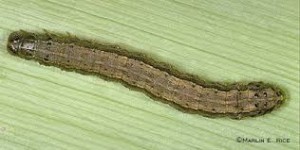Please be aware that there have been several reports of worms in peanuts. The foliage feeders that I have observed were Fall Armyworm caterpillars. The treatment threshold for foliage feeding caterpillars in peanuts is 4-8 larvae/row ft. The low level of four caterpillars/row ft. should be used if the peanuts are small and/or stressed. The higher level of eight caterpillars/row ft. may be used if the middles have lapped or close to lapping. Also, the higher threshold level is acceptable if the peanuts are healthy and vigorously growing. Depending upon the type of foliage feeder present, there are numerous insecticide treatment options. However, consideration of effect on beneficial insect population should be used during insecticide selection.
Dr. Mark Abney (UGA Peanut Entomologist) has reported Lesser Cornstalk Borer (LCB) activity in South Georgia. Fields will need to be scouted to determine the presence of LCB. Also, be observant of LCB moths from the peanut foliage as you walk fields. Keep in mind, that LCB thrives in hot, dry conditions and light sandy soils. When scouting for LCB, check several locations in each field by pulling and examining one to three plants at each location. By pulling up the plant, you can more easily locate the caterpillars. When examining the plants look for larvae, feeding damage, and silken tubes covered with soil. It may be challenging to find the larvae because they are often inside the silk tubes or inside the stems of the peanut plant.
Currently, the only recommended product for LCB control is granular Chlorpyrifos (Lorsban 15G). The liquid formulations of Chlorpyrifos are not registered for foliar application in peanuts. Please remember that granular chlorpyrifos cannot be applied by airplane to peanuts. To be effective granular chlorpyrifos must have rainfall or irrigation. The application of Chlorpyrifos will kill beneficial insects and increase the risk of foliage feeding caterpillars and spider mites. Research conducted at UGA has found that foliar insecticides do not provide control of LCB. Dr. Mark Abney is currently testing a variety of foliar insecticides against LCB and we will provide the results when available. LCB populations can be slowed by rainfall and cooler temperatures. But, once an outbreak of LCB has occured, we cannot depend on rainfall alleviating the situation. Lesser cornstalk borer is probably the most serious pest of peanuts in Georgia. It is important to observe fields for moth activity and examine plants regularly.


